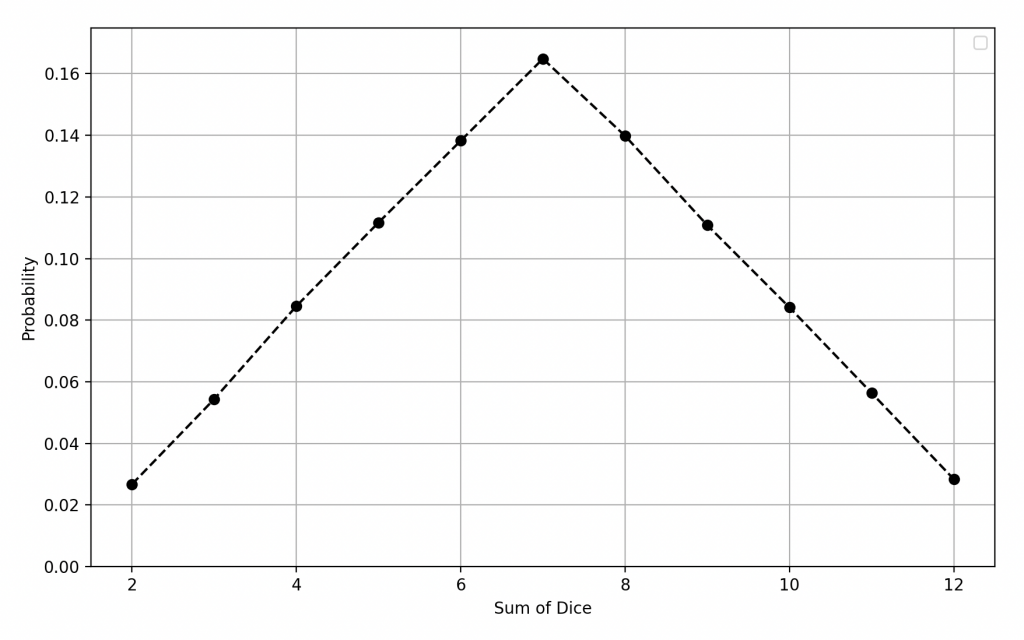The dice are cast, a heavy silence resonates as the billiard ball heads toward the crack in the wall. However, fate seems not to be on their side this time. The billiard ball hits the wall and awkwardly bounces on the cell floor, emitting a faint muffled sound. A tense silence settles among the adventurers, broken only by the slight echo of the ball’s bounce.
Despite the adventurers’ incessant calls to try, as a last resort, to charm or bribe the guard, none of them appear. The cell remains desperately locked, and the magician, unperturbed, continues her discourse on the triangular probability law, seemingly oblivious to her companions’ disappointment. The dice, it seems, have decided to keep them captive for a little while longer.
The Law of Two Dice
Magician: My dear friends, now that you have a solid understanding of the discrete uniform distribution, let me talk to you about another intriguing distribution, the triangular distribution, which occurs when we roll two six-sided dice and add the values obtained on their top faces.
Unlike the uniform distribution we discussed earlier, the triangular distribution has a different distribution of probabilities.
For a simple roll of a fair and unbiased six-sided die, the probability of obtaining any value from 1 to 6 is evenly distributed, which is 1/6 for each outcome. This constitutes a discrete uniform distribution. However, when we roll two dice and sum the values, the outcomes are no longer uniformly distributed but rather follow a triangular distribution.

Sum of dice is 2: Probability 1/36
Sum of dice is 3: Probability 2/36
Sum of dice is 4: Probability 3/36
Sum of dice is 5: Probability 4/36
Sum of dice is 6: Probability 5/36
Sum of dice is 7: Probability 6/36
Sum of dice is 8: Probability 5/36
Sum of dice is 9: Probability 4/36
Sum of dice is 10: Probability 3/36
Sum of dice is 11: Probability 2/36
Sum of dice is 12: Probability 1/36

As you can see, the most probable sum is 7, with a probability of 6/36, while the extremes, 2 and 12, have the lowest probability, with only 1/36.
There are several possible combinations with two six-sided dice to obtain a specific sum. Let me list them for you:
To get a sum of 2, there is only one possible combination: 1+1.
To get a sum of 3, there are two possible combinations: 1+2 and 2+1.
To get a sum of 4, there are three possible combinations: 1+3, 2+2, and 3+1.
And so on, until we reach a sum of 12, which has only one possible combination: 6+6.
This triangular distribution is fascinating because it reflects how probabilities are distributed when we combine the results of two dice. Keep in mind that this knowledge could prove useful in your future adventures, as it will allow you to estimate the chances of success when dealing with situations where you need to make complex dice rolls.
It's not Over!
However, it’s important to remember that everything that has just been narrated is not the true end of the story but rather a variation of what could have happened.
In the world of role-playing games, possibilities are endless, and the fate of our adventurers often depends on the players’ choices and the Game Master’s decisions. So, let the quest continue, for every adventure is unique and unpredictable, and new challenges await our brave heroes in the dark corners.
Find the true ending.
Bibliography
M. Fréchet, M. Halbwachs, Le calcul des probabilités à la portée de tous, Dunod, 1924, 297 p.
C. Barboianu, Probability Guide to Gambling. The Mathematics of Dice, Slots, Roulette, Baccarat, Blackjack, Poker, Lottery and Sport Bets, INFAROM Publishing, 2006, 316 p
P. Nahin, Digital Dice. Computational Solutions to Practical Probability Problems, Princeton University Press, 2008, 263 p.
I. Stewart, Do Dice Play God?: The Mathematics of Uncertainty, 2019
import matplotlib.pyplot as plt
import numpy as np
# Number of simulations
n_simulations = 100000
# Simulations of rolling two dice and calculating sums
results = np.random.randint(1, 7, size=(n_simulations, 2))
sums = np.sum(results, axis=1)
# Calculation of probability density
unique, counts = np.unique(sums, return_counts=True)
probability = counts / n_simulations
# Creating the probability density plot
plt.figure(figsize=(10, 6))
plt.plot(unique, probability, marker='o', linestyle='--', color='black')
# Labeling axes and adding a title
plt.xlabel('Sum of Dice')
plt.ylabel('Probability')
# Limiting the y-axis scale from 0 to the maximum probability
plt.ylim(0, max(probability) + 0.01)
# Displaying the legend
plt.legend()
# Displaying the plot
plt.grid(True)
plt.show()
